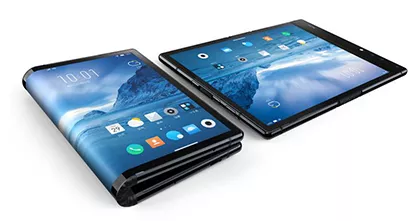

Hotline:0755-22277778
Tel:0755-22277778
Mobile:13826586185(Mr.Duan)
Fax:0755-22277776
E-mail:duanlian@xianjinyuan.cn
Flexible screen shielding film materialGenerally refers to flexible OLED. Compared to traditional screens, flexible screens have obvious advantages. They are not only thinner and lighter in size, but also have low power consumption, which helps to improve the device's battery life. At the same time, based on their bendable and flexible characteristics, their durability is much higher than traditional screens and reduces the probability of accidental damage to the device.
In October 2018, Rouyu released the world's first foldable screen mobile phone, the Roupai. It is expected that more mobile phone manufacturers will join the research and promotion of flexible screen phones in 2019.
So what types of thin film materials are involved in flexible screens? Let's take inventory together.

Transparent Polyimide Film (CPI Film)
Although flexible screens can achieve bending, frequent bending can lead to fatigue problems similar to metal paper. If a flexible screen is bent multiple times and used for a long time, it may experience creases and damage in the middle of the screen after being subjected to multiple compression and tensile stresses. In addition, circuit boards and components may also suffer damage or other accidents during folding after being subjected to a large amount of bending and non bending. The existing glass panels cannot meet their high-frequency requirements, and mobile phone manufacturers mainly use CPI film to replace the existing glass cover. CPI itself has good foldability, but PI material cannot meet the hardness requirements, and a coating needs to be added to the surface of the PI film to enhance hardness.
The global patent application volume of CPI film accounts for only about 9% of the global PI film patent application volume, while China's patent application volume accounts for only about 2.6%. Overall, the patent technology reserves in the CPI film field are relatively low. Worldwide, manufacturers with CPI film technology capabilities include Kolon, SKC, and Sumitomo Chemical. Domestic companies involved in CPI film research and development are also emerging one after another.
BOPET film is the base or bottom film of various functional films in many flexible display screens, among which the most commonly used mobile phone panel screen touch core ITO film (indium tin oxide semiconductor transparent conductive film) is prepared by coating conductive material indium tin oxide on the surface of BOPET film as the substrate. However, the brittleness of ITO is not suitable for the application of flexible screens. The industry has proposed using silver nanowires AgNWs with heptathlon to replace ITO as the core conductive material for touch control. However, silver nanowires are difficult to achieve narrow borders and have obvious etching marks, which need further improvement. The core conductive material replacing ITO is mainly nano silver conductive film, but the substrate of nano silver conductive film is also mainly BOPET film.
During the bending process of OLED, in order to prevent damage and bending of the screen, it is generally necessary to stick a protective film at the bottom of the panel. This protective film has good rigidity and its basic material is BOPET film.
Cycloolefin polymer film (COP film)
Developed and produced by R&D engineers from Japan's Rayon Corporation for flexible film shielding materials, a resin that was initially used in medical applications is characterized by high transparency, low birefringence, low water absorption, high rigidity, high heat resistance, and good water vapor tightness. In some special fields where high transparency and UV resistant conductive films are required, COP film is used as a substrate instead of BOPET.
Liquid Crystal Polymer Film (LCP Film)
LCP film has good properties such as high strength, high rigidity, high temperature resistance, and electrical insulation. At the same time, it has better water resistance compared to PI film, making it a more excellent type of film than PI film. Currently widely used in flexible screen cables, flexible phone antennas, speaker diaphragms, etc.
PE PROTECTION FILM
In addition to the protective film that prevents panel bending and damage, during the production and transportation process of flexible screens, a large amount of self-adhesive protective film made of PE as the substrate needs to be consumed at once to protect electronic screens from foreign objects scratching or intermediate links staining. Common self-adhesive materials include EVA, ultra-low density polyethylene, and polyolefin thermoplastic resin. The characteristics of self-adhesive protective film: simple processing flow; Long term use without residual glue phenomenon; Low material cost; The product variety is limited and is used in high-end electronic devices.
Polydimethylsiloxane film (PDMS film)
Flexible film shielding materialPDMS film is a type of high molecular elastic polymer film prepared from polydimethylsiloxane through a special process. Due to the characteristics of polydimethylsiloxane materials, PDMS films are endowed with certain specific properties: high elasticity, low Young's modulus, excellent gas permeability, chemical stability, thermal stability, low-temperature flexibility (maintaining excellent performance at -60~200 ℃), full transparency, and biocompatibility. At present, PDMS films have varying degrees of application in high-end products such as scar patches, electronic flexible devices, microfluidic chips, gas separation technology, and smart wearable products.

Advanced Institute (Shenzhen) Technology Co., Ltd, © two thousand and twenty-onewww.avanzado.cn. All rights reservedGuangdong ICP No. 2021051947-1 © two thousand and twenty-onewww.xianjinyuan.cn. All rights reservedGuangdong ICP No. 2021051947-2